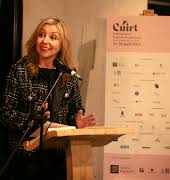
Love may be blind but this Netflix reality show is also completely tone deaf
By Amanda Cassidy
15th Mar 2020
15th Mar 2020
It’s billed as a dating show with a difference. But for Amanda Cassidy, the Netflix show raises more than a few red flags
The challenge sounds simple enough. Find love without ever seeing your partner. It begins with a series of meetings in ‘pods’ where contestants can hear each other but not see their face, race, height or any other distinguishing features that we use as markers in real-life dating scenarios.
It’s watchable in that way you are equally enthralled and horrified to witness what is unfolding before your very eyes.
The speed-dating type meetings allow contestants to have quite intimate and surprisingly intense talks to a voice they can’t see in this tiny room with only a couch. They then choose whether or not TO GET MARRIED to that person. You know, after 5-7 days.
It is deliciously addictive, watchable in that way you are equally enthralled and horrified to witness what is unfolding before your very eyes. Initially, I had so many questions, why would you do this? WHY would you do this? What compels someone to do this? Why would anyone do this?
Understandably, it’s been a huge hit for Netflix since the 10-episodes dropped in February and it’s been making waves worldwide. Millions have invested their Friday and Saturday nights following the couples as they propose, unveil to each other what they look like in reality (handy when they are all slim, good-looking, shiny models) go on a honeymoon, live together and eventually decide whether or not to marry.
So far, so quality reality TV junk.
Idealistic
But imagine a world where we are evaluated on our merits rather than our biases when it comes to looks. This show dangles before us the tantalising idea of a society where our most entrenched social hierarchies can be put aside.
It might sound idealistic, but the truth is that there is more to relationships than just a meeting of minds. We’ve been primed biologically to be drawn to things like height and eye-colour and shape. Our biases are inbuilt, hard to shake off.
But the real psychological clanger when it comes to Love is Blind is the heartbreak of those around the contestants.
Heartbreak
It preys on the American dream of instant everything. The add-water-and-stir relationships.
The premise of the show is that neither couple tells the other whether or not they are DEFINITELY going to go ahead with the wedding or not. The wedding venue is set, the extended families show up in their finery, the bride gets into her gown and groom is decked out in his suit. The production team have obviously tweaked the script to ensure the ultimate decision is only to be made face-to-face at the altar with everyone watching.
It is cruel beyond belief. For everyone. So when the majority reject their ‘fiance’ at the altar (“No, I don’t want to marry you”) you can almost hear their hearts break. Their families presumably never signed up for this either.
It is unfiltered devastation to see the mother of the bride chase down her daughter who’s just been dumped with her wedding dress in disarray to hug her tightly, sobbing and heaving together.
For me, it stopped being entertainment. It morphed into something that exploited those desperate to find love. It offered them something that looked like hope and a future and then laughed in their face. It preyed on the American dream of instant everything. Add water and stir relationships.
Some people might do anything to be famous and love might indeed be blind. But the experiment, in this case, failed when they expected these strangers to marry after 30 days. And then filmed their families’ tears when it all went wrong.
Image via Netflix
Read more: 7 series worth watching if you are stuck inside























